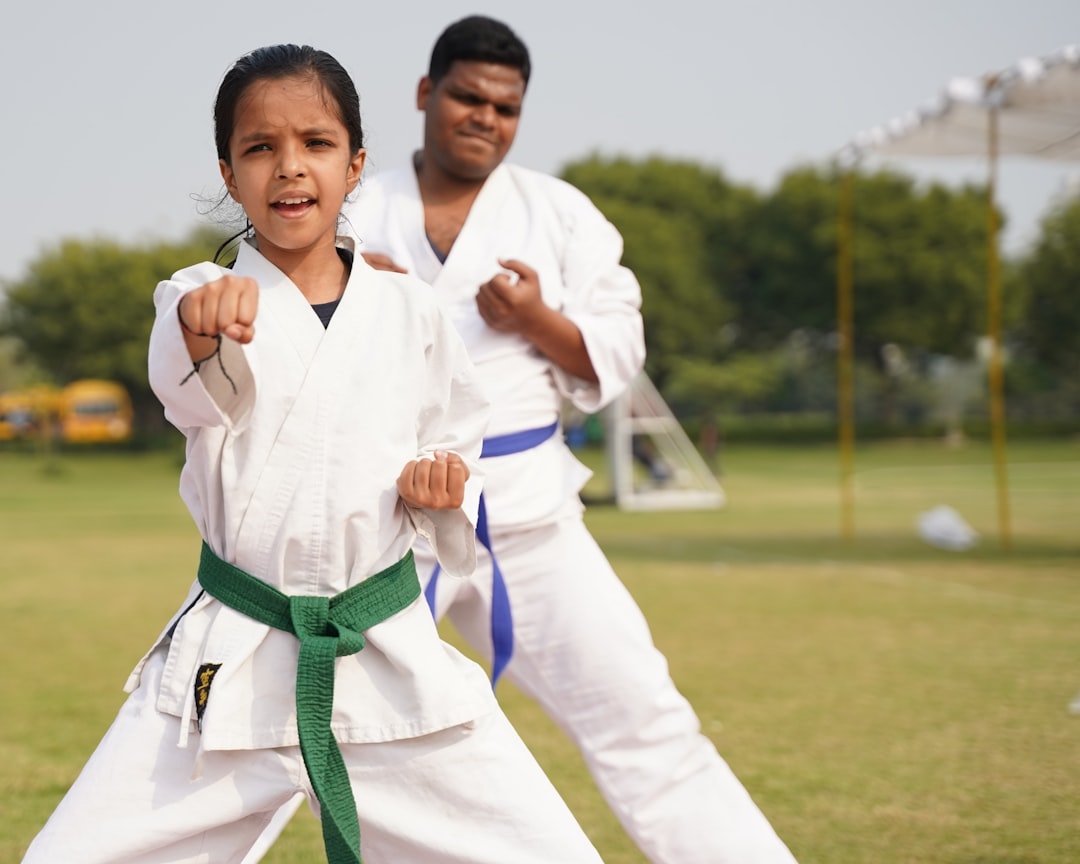Martial arts uniforms, or "gi," are essential for practice due to their functional and symbolic importance. A gi typically includes a jacket, trousers, and a belt, made from durable materials that facilitate movement and offer feedback on technique. The color and style of the gi can vary depending on the martial art and its rank system, with each belt signifying progress and dedication within the discipline. In grappling arts like judo or Brazilian jiu-jitsu, lighter gi jackets are necessary. Selecting a suitable gi should be guided by your martial arts instructor or adhere to your discipline's specifications. The martial arts community actively supports inclusivity through initiatives that provide access to equipment like gis for those who face economic barriers, emphasizing the shared values of respect and tradition within the sport.
Historically, the gi has roots in Okinawa, Japan, with its design influenced by the Chinese keikogi, evolving into a global symbol among martial artists. The World Karate Federation regulates the standards for gis to maintain tradition. Additionally, initiatives like 'Donate Karate Equipment' play a vital role in ensuring that individuals worldwide can participate in karate, preserving its rich heritage. Protective gear such as gloves and shin guards are also highlighted as necessary for striking arts like karate and kung fu, and donating these items can be both beneficial to those in need and sustainable for the sport. Tax deductions are available for donors who contribute their used karate equipment to qualified organizations. When donating your own gear, ensure it is clean, undamaged, and fit for use before passing it on to a local dojo or martial arts organization. This act of giving not only supports aspiring practitioners but also upholds the legacy of martial arts traditions.
Martial arts uniforms, commonly known as gis, are more than mere attire; they represent tradition, discipline, and respect within the martial arts community. This article delves into the significance of these garments, from their historical roots to their modern-day usage. We’ll explore various martial art forms and how each has its unique uniform, with a particular focus on karate gis and the importance of donating karate equipment responsibly. Join us as we unravel the role of these uniforms in practice, competition, and tradition, ensuring every practitioner can access the essential tools for their martial journey.
- Understanding the Role of Martial Arts Uniforms: Gi and Beyond
- The History and Significance of Karate Gis: A Legacy to Honor
- Essential Components of a Martial Artist's Uniform: Style-Specific Details
- How to Donate Karate Equipment Responsibly: Ensuring Your Gi Finds a Good Home
Understanding the Role of Martial Arts Uniforms: Gi and Beyond

Martial arts uniforms, commonly referred to as “gi,” play a significant role in the practice of martial arts, serving both functional and symbolic purposes. The gi is a traditional training garment consisting of a jacket, trousers, and belt, designed to facilitate movement and provide feedback on technique during practice. Made of cotton or hemp, these uniforms are durable and allow practitioners to execute techniques cleanly without causing injury. Do you wonder where you can find a martial arts uniform suitable for your practice? Often, martial arts schools or local sports stores carry gi that meet the necessary standards for different disciplines. Additionally, many organizations and individuals donate karate equipment, including gi, to those in need within the community, ensuring that accessibility is not a barrier to participation.
Beyond the gi, the belt system within martial arts signifies rank and progress, symbolizing the journey of personal growth and mastery. While the white belt represents the beginning of this path, each subsequent belt color carries its own meaning and significance within the art. The quality and style of the uniform can also vary depending on the martial art being practiced, with some styles, like judo or Brazilian jiu-jitsu, requiring lighter jackets that allow for grappling techniques. How do you ensure your martial arts uniform is appropriate for your discipline? It’s essential to consult with your instructor or refer to the specific requirements of the style you are practicing. This will help you choose the right gi, ensuring both adherence to tradition and functionality in your training.
The History and Significance of Karate Gis: A Legacy to Honor

Martial arts uniforms, commonly known as gis, have a rich history deeply intertwined with the practice of karate, a martial art that originated in Okinawa, Japan. The gi serves as more than just a garment; it is a symbol of tradition, discipline, and respect for the art. Evolving from the Chinese keikogi, which was introduced to Okinawa through the Ryukyu Kingdom, the karate gi has undergone subtle changes while maintaining its core design. The top, known as the jacket or ‘uppers’, and the trousers, referred to as the ‘lowers’, are made of heavy cotton or hemp fabric, providing both comfort and durability for the practitioner.
Throughout the years, the gi has remained a pivotal aspect of karate culture, emphasizing modesty, respect for one’s peers, and dedication to the discipline. It is a legacy that each practitioner wears with honor during training and competition. As the art of karate spread globally, the gi became an emblem of unity and shared values among martial artists worldwide. Today, organizations like the World Karate Federation have specific guidelines on the dimensions and design of gis to ensure uniformity and respect for the sport’s traditions. Additionally, initiatives such as ‘Donate Karate Equipment’ programs help in providing gis to those who may not have access to this essential gear, ensuring that the tradition lives on and is accessible to all who wish to practice karate with honor and dedication. Do you know what inspired the design of the traditional karate gi? The gi’s design was influenced by both practicality and cultural significance, reflecting the martial art’s values and origins. Are you aware of how initiatives like ‘Donate Karate Equipment’ contribute to the preservation of martial arts traditions? Such programs facilitate access to proper training attire for individuals who might not otherwise be able to afford it, thus ensuring the continuity of karate’s rich heritage.
Essential Components of a Martial Artist's Uniform: Style-Specific Details

Martial arts uniforms, often referred to as “gi” or “keikogi” in judo and jujutsu, serve as more than just a garment; they are an integral part of the practice, signifying respect for the discipline and the dojo. Each style of martial arts has its own specific uniform that reflects its unique traditions and functional requirements. For instance, in karate, the gi typically features a belt called an “obi,” which holds the garment closed at the waist and indicates the wearer’s rank or level within the martial art. Do you know where you can donate your used karate equipment, including these belts? You might consider reaching out to local dojos or organizations that specialize in providing gear for those who are new to martial arts and cannot afford their own uniforms.
In addition to the gi, protective gear such as gloves and shin guards are essential components for certain styles, particularly those involving striking techniques like karate or kung fu. These items ensure the safety of both the practitioner and their partner during practice or competition. When the time comes to replace your equipment or if you find yourself with extra gear that you no longer need, consider donating it to a martial arts school or a community center. This not only helps those in need but also contributes to the sustainability of the sport by keeping usable gear out of landfills. What’s more, many organizations will appreciate your contribution and may even offer a tax deduction for your generous donation of karate equipment and other martial arts uniforms.
How to Donate Karate Equipment Responsibly: Ensuring Your Gi Finds a Good Home

When the time comes to part ways with your karate equipment, particularly your gi – the traditional uniform of martial arts – it’s crucial to consider how to donate your gear responsibly. The best way to ensure your gi finds a good home is by researching local dojos or martial arts organizations that may be in need of quality uniforms for their students. Are there any nearby studios or schools specializing in karate where the equipment could be put to immediate use? By reaching out to these establishments, you can provide them with much-needed resources while also supporting the growth and development of martial arts in your community.
Before donating your gi, it’s important to assess its condition. Is the gi still in good shape, without significant wear or damage? If so, it’s likely suitable for donation. Once you’ve identified a potential recipient, clean the gi thoroughly to ensure it’s fresh and sanitary for the next practitioner. Additionally, consider including any accompanying equipment, such as belts or protective gear, if they are in good condition as well. By donating your karate equipment responsibly, you not only contribute to the continuation of martial arts traditions but also help aspiring martial artists who may not have the resources to acquire their own gear.
Martial arts uniforms, commonly referred to as gis in judo and karate, serve as more than mere garments; they are a testament to tradition, skill, and respect within the martial arts community. This article has explored the multifaceted role of these uniforms across different styles, delving into the history and significance of the karate gi, and providing insight into the essential components that make up a martial artist’s attire. A key takeaway for practitioners and enthusiasts alike is the opportunity to contribute to the community by donating karate equipment responsibly, ensuring these vital pieces of martial arts heritage are passed on and continue to support new generations in their training and growth. As we conclude, it is clear that martial arts uniforms are integral not only to the practice itself but also to the legacy and values they represent.
